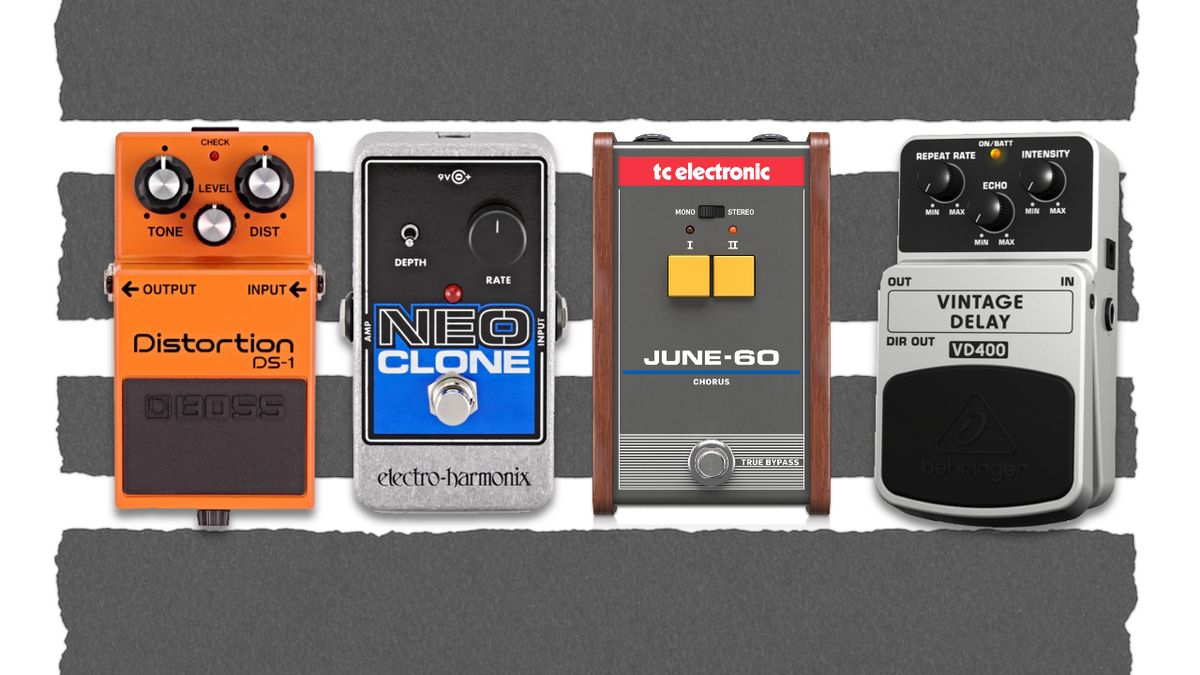
It’s a new year, which means new beginnings and maybe a renewed drive to introduce some fresh sounds to your pedalboard. But what if you’re on a budget? Well, you might be in luck – we’ve rounded-up 12 cheap guitar pedals that will spark new ideas and help you create new sounds, without blowing your savings.
When we were coming up through the ranks, there weren’t many options other than Boss pedals or pawn shop pot luck. These days though, there are legions of choice budget pedal picks for all effect types, from major brands including Ibanez and TC Electronic. From the most popular overdrives in the world to reissues of cult favourites, you’d be surprised at what you can pick up for not more than the cost of a couple of guitar cables.
Although once upon a time a low price almost certainly meant low quality, that’s no longer the case.
OEM manufacturers (that is, the companies that own the factories that manufacture goods on behalf of big brands) setting up distribution for their own brands and selling direct to consumers has done for Chinese manufacturers what the 80s did for Japanese music companies like Maxon. You might not have heard of the brands, but the pedals speak for themselves.
In addition to OEM manufacturers getting in on consumer demand for designs they’ve worked on, there’s the greyer area of cloning. Indeed, a number of manufacturers certainly take advantage of the fact that guitar pedals are easy to reverse engineer. Though a PCB and layout can be copyrighted, a circuit in the abstract cannot be.
Then again, the history of guitar effects, especially overdrives and fuzzes, is one of cloning, ‘taking inspiration’ and lightly tweaking existing circuits. Even some of the biggest players in the game have played pretty fast and loose with the designs of others at times.
The upshot of all this is more choice for consumers, and at a lower price point. This has, in turn, resulted in some larger brands offering new budget lines. Among these, the Ibanez mini pedals and big-box TC Electronic pedals are notable examples.
Meanwhile, other companies like Electro-Harmonix have always had affordable pedals in their line, and have had to litigate against cloners stealing their designs. Infamously, EHX won a lawsuit after discovering that Mooer had wholesale copied their POG code for their Tender Octaver.
So, that’s the background. The question is – what’s the catch to you, the buyer? Simply put, there generally isn’t one.
* The best guitar cables for acoustic, bass and electric
* Tidy up your budget ‘board with the best patch cables
Most analogue effects are just a bag of cheap transistors, resistors, capacitors and diodes. So long as the PCB is well-designed and there are no noise issues, you can’t really go wrong.
On some mini pedals, because of the tight spacing, noise issues can crop up – and it’s this, an annoyance, rather than a catastrophic failure – that is most common with cheaper mini pedals.
More complicated digital circuits are harder to clone, more expensive to develop, and more expensive to manufacture at scale. As a result, they’re less foolproof when compared to their competitors from established brands. This is why we’ve stuck mainly to recommending analogue pedals.
Finally, as already discussed, established brands also offer ranges of budget pedals, bypassing most of the potential consumer concerns outlined above.
The June 60 looks like it should be a lot more expensive than it is. It’s an analogue chorus pedal billed as a reproduction of the chorus found in the Roland Juno 60 synthesiser. As a result, it doesn’t always perfectly translate to guitar, and with only two modes compared to say, the Boss DC-2’s four, sometimes the depth and rate you want isn’t on offer. Still, it’s about a third the price of the DC-2W reissue and even has a stereo out, assuming you use a TRS-Y cable. Also, look at it!
The Mosky Deluxe is a bargain even on a list of bargains. It’s a clone of the Lovepedal Amp 11, itself clones the superb Paul Cochrane Timmy for its core drive circuit. What you get with the Deluxe is a versatile, punchy two-footswitch overdrive. The left side is a Timmy with diode switching options, and the right is an Electra overdrive, like on the Lovepedal Amp 11. The additional switch allows you to remove the clipping diodes, making it a clean boost rather than a second drive stage. Cram that punching power into a tiny enclosure and similarly minuscule price, and it’s almost too good to be true.
Coming in at not far off the price of a Tubescreamer clone, the Ibanez Tube Screamer mini is the definition of a bargain. It’s got the original TS-808 sound, true bypass, and it looks super cute. What’s not to like?
The Boss FZ-2 fuzz pedal has long been the subject of pleas for a Waza Craft reissue. The FZ-2 was a modernised Univox Super Fuzz with switchable modes and two-band EQ, discontinued in the late 90s. For whatever reason – those in the know have sometimes mooted availability of the right transistors – Boss has demurred on a reissue. This has left the coveted pedal to grow in cult popularity. Luckily for those needing a fix, Behringer released a clone, the SF300. It’s close enough that you’d be hard-pressed to tell them apart. There’s even DIY guides available online for rehousing the guts of the pedal in a more robust metal enclosure if you want a project.
Though it’s described as ‘transparent’, the Klon Centaur is anything but. Whatever adjective you care to use, there’s no denying that it’s a great overdrive. Decent clones of the Klon will often run to a couple of hundred dollars, so a budget version is most welcome. The Golden Horse doesn’t have the switchable buffer of the original, but apart from that it’s close enough in sound that you’d be hard-pressed to tell it apart from any well-made klone.
Though there’s a few options for mini-sized analogue delay pedals at around the same price, we always like slightly larger delays so that we can bend down and twist controls live. In that regard, the TC Echobrain is a fun unit. The controls are intuitive, with plenty of scope for runaway oscillations and psychedelic weirdness. If you’re after it not for weirdness, but for a solid, warm analogue delay sound then of course it has that in spades.
Though we’ve not had the time to take ours apart, the buzz on the internet is that the Black Secret distortion pedal uses a surface-mount LM-308 op-amp, the same as the original, iconic ProCo RAT. The slow slew rate of the LM-308 resulted in almost triangular-wave clipping at higher gain levels. This accounts for the different, highly-coveted sound of vintage RATs, so if true, this is even more of a bargain. Even without the LM-308, it’s a diminutive beast that packs a mean punch. It can be switched between classic and turbo mode, and in classic mode has a fantastic range, going from light dirt to full-bore hurricane.
To our ears it’s still one of the fizzier distortions, and we wish it had some more volume on tap, but we can’t deny it’s a classic. For many, the BOSS DS-1 was their first pedal, and at this price point it’s easy to see why it’s still so popular. If you want a no-frills distortion that will likely outlive you, then you can’t go wrong with the orange mean machine.
The Oceanic is a simple reverb pedal with subtle modulation that allows it to cover a lot of ground. NUX claim that they’ve carefully modeled the algorithm such that additional controls are unnecessary, hence it being single-knob. While we’re not sold on that argument, it is true that with decay set at 9 o’clock it’s a different pedal than with the decay knob dimed. The pedal goes from ‘studio tiled bathroom’ through ‘concert hall’ to the kind of huge, abstract atmospheric space that will get all the shoegaze space cadets all hot and bothered. There is a wet/dry control on the Oceanic. However, to access it you have to hold down the footswitch for two seconds, at which point the decay knob becomes a level knob.
You’ll have heard the EHX Small Clone on any number of records, not least Nirvana’s Nevermind. If you’re looking for a glassy chorus tone, it may well be that the sound in your head is the Neo Clone. It’s as simple and intuitive as the bigger-box original, with only a single rate knob and depth switch. Despite being more compact, it has the classic EHX looks and name to back it up.
Another in Behringer’s line of Boss clones, the VD400 is their challenger to the Boss DM-2. If you can get over the plastic enclosure, then you’ll find a decently made, good-sounding delay pedal. Again, like the SF300, there are guides online for rehousing it, should you be worried about its longevity.
The Steel Singer is a clone of a clone, Vertex’s Steel String Singer. Vertex had a prolific period of pinching designs and writing lots of marketing copy about how they had actually designed them. In any case, the SSS was in reality a Jack Orman designed clean boost. Luckily, Jack Orman knows his stuff, and his amp-in-a-box boost pedal design lives on in this NUX offering. As an aside – Orman’s list of mods for popular pedals are legendary, so if you own for example a Big Muff clone with mids control, that’s probably Orman’s ‘presence control’ mod in action!
This Post was originally published on guitarworld.com
